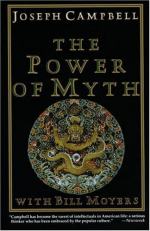
|
| Name: _________________________ | Period: ___________________ |
This test consists of 15 multiple choice questions and 5 short answer questions.
Multiple Choice Questions
1. Which of the following is the best definition for the term "sanctify" as used in the following sentence: "They sanctify their own local landscape."
(a) Bless
(b) Desecrate
(c) Defile
(d) Destroy
2. How does Chapter 3 differ from the other chapters in this text?
(a) There are little references to Campbell's own personal experiences.
(b) There is little mention of mythology.
(c) There are no references to Moyers.
(d) There is little mention of eastern religions.
3. What does Campbell state about sacred places?
(a) The current society does not value them.
(b) They do not exist.
(c) There are only a few still in existence.
(d) People visit them enough.
4. When the Jews were in Babylon their God was ____________.
(a) Unknown
(b) The savior
(c) A local tribal god
(d) The same as the present day god
5. How were myths and legends handed down before the invention of writing?
(a) They were often lost and not handed down
(b) Rituals only
(c) Oral traditions only
(d) Rituals and oral traditions
6. Where was the physical scope of Biblical mythology?
(a) Rome and Italy
(b) Middle East
(c) Far East
(d) North America
7. All mythologies indicate that the idea of God is unknowable and is the what?
(a) Ultimate mystery
(b) Ultimate goal
(c) Beyond nature
(d) Ultimate explanation
8. Which of the following is not one of the universal themes identified by Campbell?
(a) Birth
(b) Death
(c) Reincarnation
(d) Identification of God
9. The accounts of legends in Africa all highlight the basic relationship between _________________.
(a) religious leaders and God
(b) people and God
(c) hunters and prey
(d) life and death
10. Of which general religion is Campbell?
(a) Christian
(b) Muslim
(c) Jewish
(d) Buddhist
11. How many universal themes does Campbell identify?
(a) 5
(b) 4
(c) 7
(d) 2
12. How many creation myths does Campbell share from the Bible?
(a) 2
(b)
(c) 1
(d) 3
13. In what time period were the Sumerian seals documented?
(a) 3500 BC
(b) 2000 BC
(c) 4000 BC
(d) 3500 AD
14. What do Campbell and Moyers indicate has lost its force and become a mere remnant of the original in regard to marriage?
(a) Social marriages
(b) Monogamous marriage
(c) Ritual marriage
(d) Polygamy
15. Which of the following is the best synonym for motif as used in the following sentence: "The motifs of creation and death occurred in both Catholic and American Indian myths."
(a) Design
(b) Theme
(c) Logo
(d) Pattern
Short Answer Questions
1. When do dreams become a part of society's myths?
2. What underlying assumption does Campbell make about human development?
3. Campbell tells Moyers that myths have helped him deal with _____________________________.
4. What do all of the hunting rituals have in common?
5. What is the architecture of a city an expression of in a society?
|
This section contains 513 words (approx. 2 pages at 300 words per page) |

|




